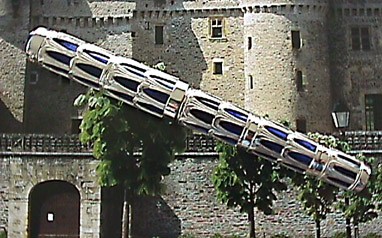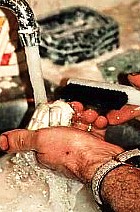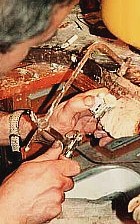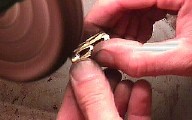

Introducing the glorious Cathedral overlay, a breathtaking expression of ancient tradition and skills translated into modern materials and artistic sensibility.The Cathedral, whose graceful design echoes the soaringly beautiful lines of medieval stained-glass cathedral windows, contains nearly one and a half ounces of gold to provide a satisfyingly weighty, yet superbly balanced writing experience. Unlike many of today's limited editions, the Cathedral is made entirely by hand, from the initial wax carving to hand-casting to the final polishing, by highly talented and skilled artisans--Kane Boutry, goldsmith, and Brian Duguay, caster. Also unlike many of today's LEs, this is truly limited--only 100 pens will ever be made in the elegant Cathedral overlay pattern. And utterly unlike other LEs, you can obtain it in 18K yellow, white, green or rose gold. Once the freshly cast overlay satisfies these perfectionists' keen eyes and sensitive fingertips, the Cathedral is painstakingly fitted to your standard Pelikan M800, Blue Ocean or Green Demonstrator, resulting in a spectacular and unique writing instrument that will inspire that sense so assiduously sought by all collectors of fine pens: "Aaaaahhhhh!" Please join us as we show you a look at the Cathedral's creation. |
 Wax: The first stepThe first step in creating the Cathedral overlay is to cast hard-wax impressions from the original mold. This complicated process requires two molds to make one impression: the design mold and an internal mandrel that forms the cylindrical hole into which your Pelikan fits. These five wax sections form the foundation of every Cathedral overlay. If something is even slightly "off," the overlay will not meet the exacting standards of our artisans. If that happens, the wax is melted and re-cast until the impression is perfect. |
 The foundational treeOnce the wax is perfect, it's attached by various-sized branches to a central trunk to form a wax "tree," which will then provide the framework for the plaster-like mold into which the gold will actually be cast.The tree is placed in a metal cylinder called a casting flask and the mold material poured over it, with the tree "trunk" forming a special channel called the "gate." This is where the molten gold will be introduced. |
 Shooting the goldBecause the overlay mold is so finely detailed and calls for such thin castings, the invested mold must be heated to precise, extreme temperatures. It's placed in a kiln and rotated frequently to ensure proper heating all around. During this step, the wax is burned off, or lost--hence the famous "lost-wax" casting method.While the investment heats, the caster places a crucible, filled with the correct ratio of gold to alloy, on a centrifuge. He then applies a torch to melt the gold, preparing to "shoot" it into the mold. At the proper time, the caster quickly transfers the mold to the centrifuge. In a motion almost too quick to follow with the eye, he starts the centrifuge and drops the lid. With the centrifuge spinning, the gold takes on the contours of the mold. |
 The hard partNow comes the hard part--the waiting. If the gold was a fraction of a degree too cool, or the mold had a bubble, or a minute crack forms, all this work is wasted. The caster will have to go back to step one and pour new wax impressions.Once cool enough, the artisan "pickles" the piece--soaks it in an acid solution to soften the mold material and remove whatchacallit. This destroys the mold and reveals the cast overlay. Still attached to its now-golden tree, the whole assembly looks dull and even a bit scorched. |
 Cutting them looseNow the caster cuts the individual overlay pieces off the tree and inspects them. This is "hold your breath" time. If he discovers any imperfection, no matter how slight, the gold goes back into the melting pot and the caster goes back to making new hard wax impressions.Our artisans have many years' experience under their belts, however, and this rarely occurs.
|
 Finishing and polishingNow that the caster is satisfied, the overlay pieces go to the goldsmith. He carefully and thoroughly refines the cast lines by filing and polishing, finishing with an encounter with a polishing wheel that wakes up the gold and causes it to glow. Now comes the hard part for the goldsmith--he must individually fit each overlay to its pen. Since the parts are hand-cast, not machined, there is always a bit of variation in their size and fit. This alone can take a day or more. |
 The final fittingNow that you've seen the way the Cathedral overlay is made, we think you'll agree that it's spectacular. More spectacular still is the way it looks overlaid on an M800 Blue Ocean or Green Demonstrator. Hold it up, let the sunlight kiss it, and the pen glows with inner life as the sun's rays draw from its depths vivid flashes of color and fire. |
 You chooseWhen you're ready to step up to your Cathedral overlay, remember--you choose the pen, you choose the color of gold (shown is a detail of white gold on Blue Ocean). If you choose white or another tint of gold, the 800's end jewels will be plated to match. You may even choose the series number you'd like, to commemorate a special date or year, providing no one else has taken it. Each Cathedral is made individually, to your taste, to your order. Each is engraved, hallmarked and numbered by hand. Only one hundred will be made; so far, seven are sold. |
The Snake arrives:For a look at the astounding new Snake overlay, click here! |